Omnimax in Copenhagen |
Read more at in70mm.com The 70mm Newsletter |
| Written by: Thomas Hauerslev | Date: 20.09.2022 |
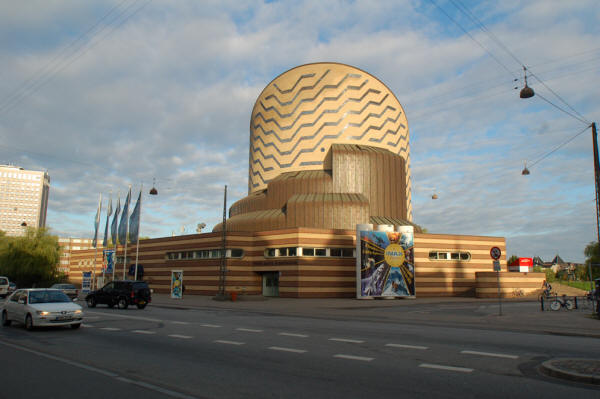 Architect
M.A.A. Knud Munk, spent three years working on the design of the
planetarium. The
building consists of a 35 meter high sloping cylinder that contains
the planetarium hall, a low building with the main entrance,
auditorium and administration as well as a vestibule with stairs to
the planetarium. Picture: Thomas Hauerslev Architect
M.A.A. Knud Munk, spent three years working on the design of the
planetarium. The
building consists of a 35 meter high sloping cylinder that contains
the planetarium hall, a low building with the main entrance,
auditorium and administration as well as a vestibule with stairs to
the planetarium. Picture: Thomas HauerslevFor 30 years (1989-2019), the Tycho Brahe Planetarium in Copenhagen ran IMAX film equipped with the Canadian Imax/Omnimax Motion Picture Projection Systems, the most spectacular of all the 70mm film formats. A film experience a bit in the same style as the "first-person" experience you could experience with Cinema 180. Equally entertaining, but technically MUCH better. The audience sat on luxury chairs in a cinema with a 30-degree incline - almost like sitting and enjoying the view on a mountainside. The "view" was a 1000 m2 dome screen that completely enclosed the audience's field of view with large sharp images and 6-channel stereo sound. • Go to Gallery: Tycho Brahe Planetarium Advertising (1989-2020) • Go to The Basics of The Rolling Loop IMAX Projector The Tycho Brahe Planetarium shut down operations as a result of the Corona pandemic on March 12, 2020. During the shutdown period, the IMAX system was dismantled and scrapped. The entire library of film prints which had been shown since 1989 were returned to the rightful owners. To replace the IMAX 70mm system, a new 8k digital "ESX Giant Dome Cinema" from Evans & Sutherland (US) has been installed. The only other cinema in Europe with this system is the former Ominmax cinema "Omniversum", located in The Hague in the Netherlands:
Since the early 1970s, IMAX Corporation has produced some of the
most spectacular documentaries ever seen, several of which have been
nominated for Oscars. IMAX gave the audience the opportunity to
travel to otherwise inaccessible places. With IMAX, the audience
came aboard the space shuttle several times; for the first time
a motion picture system gave ordinary people the opportunity to see the Earth in live images
in unprecedented richness and detail. NASA's astronauts even described
the IMAX experience as the next best thing, to being there
themselves. Everywhere, the big IMAX camera has photographed our
world on razor-sharp 65mm film, from the hot sands of the Sahara desert to the
deep under water wreck
of the Titanic. From the cold
South Pole to the world's vast tropical rainforests. From the
top of Mount Everest in the Himalayas and the Grand Canyon in the
United States to the Great Barrier Reef in Australia. The
audience admired the big sharp images because it gave them a great
illusion of being there themselves. |
More in 70mm reading: Gallery: Tycho Brahe Planetarium Omnimax Advertising (1989-2020) The Basics of The Rolling Loop IMAX Projector The Birth of IMAX Historical Wide Screen Gathering The Passing of Bill Shaw in70mm.com's IMAX Page 70mm Cinemas and Film in Denmark biografmuseet.dk: Omnimax film @ the Tycho Brahe Planetarium |
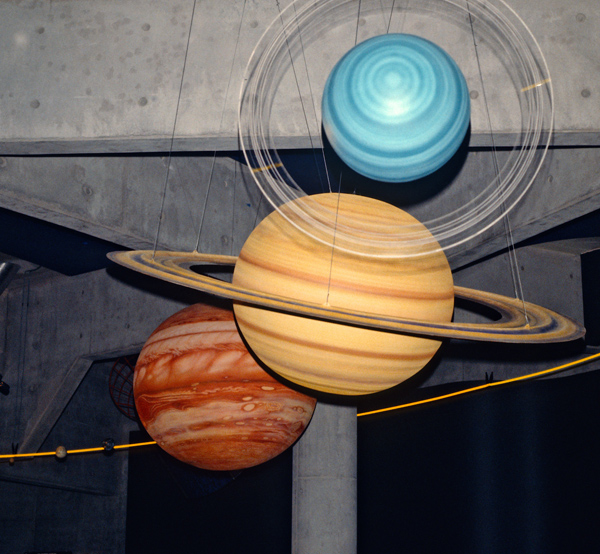 The
"Tycho Hall", just below the planetarium hall with large models the
planets of the solar system, surrounded by a yellow neon ring
symbolizing the size of the Sun. 1989 Photo: Thomas Hauerslev The
"Tycho Hall", just below the planetarium hall with large models the
planets of the solar system, surrounded by a yellow neon ring
symbolizing the size of the Sun. 1989 Photo: Thomas HauerslevThe Tycho Brahe Planetarium was a gift to the city from Bodil Pedersen (1905 - 1995), daughter of Thorvald Petersen, founder of pharmaceutical company Novo in 1925, and her husband Helge Pedersen (1905 - 1998), both of whom very interested in astronomy. They wanted to share this interest with the Danes. At the time of the gift in 1985, it was planned that the Planetarium would open in December 1987 and that it was to become the best equipped and most modern planetarium in the entire world. A versatile culture house where 350,000 - 400,000 guests a year could be expected. It would be a new tourist attraction in Copenhagen. There should also be an opportunity to show laser shows and computer graphics. The entertainment value was also considered to be high, as the Planetarium was to be equipped to show Omnimax movies. It was budgeted that ticket and souvenir sales could finance the operation. Architect M.A.A. Knud Munk, spent three years working on the design of the planetarium. The building was located close to Skt Jørgen's lake and consists of a 35 meter high sloping cylinder containing the planetarium hall, a low building with main entrance, auditorium and administration and a vestibule with stairs to the planetarium hall. The interior is made of raw concrete in a brutalist style. In the building there are also teaching facilities and exhibition space for the changing exhibitions. The first exhibitions were about Tycho Brahe, ESO (European Southern Observatory) and generally about astronomy and space exploration. Towards the lake there are restaurant facilities and the house restaurant Cassiopeia had room for 90 guests indoors and 75 guests outdoors. In the center of the building is the planetarium hall with the impressive dome canvas of 23 meters in diameter. The screen area is 1000 m2 and built up of perforated aluminum sheets. Except for a small part at the very top, about 800 m2 of the screen was used when IMAX movies were shown. All 1000 m2 were used for the Zeiss star projector. The Planetarium Hall is a circular space that is inclined 30 degrees to the horizontal plane. There is room for 273 guests sitting in comfortable French Quinette chairs in turquoise fabric as well as space for three wheelchairs. All 11 rows of chairs are arranged amphitheatrical to ensure a strong illusion of being in the universe. The audience enters at the bottom of the hall before the performance starts, and exits at the top after the performance. An elevator has been installed for the projection room and the exits from the hall. The planetarium also houses a large showroom "Tycho Hall" - arranged just below the planetarium hall. Here you can learn all about our own solar system. Large models of all the planets of the solar system, surrounded by a yellow neon ring symbolizing the size of the Sun. A genuine Moon-rock from Apollo 17's mission to the Moon in 1972, a large panorama from the moon's surface and several other things are on display. You could say that this area is the cinema's foyer, where guests are waiting to be let in before the movie begins. |
|
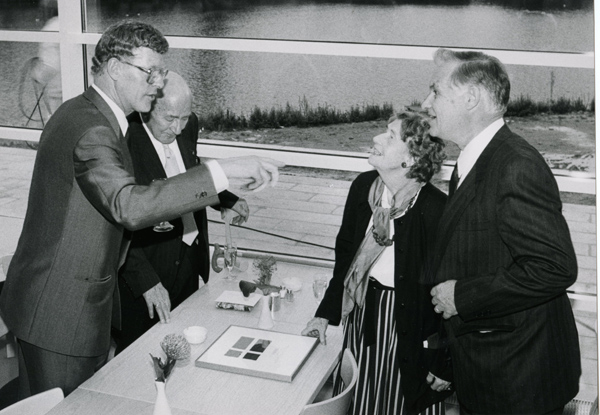 Bodil
and Helge Petersen with IMAX's William C. Shaw (right) at the
inauguration of the Tycho Brahe Planetarium in 1989. Bill Shaw
(1929-2002) was one of the founders of IMAX with Graeme Ferguson,
Roman Kroitor and Robert Kerr. Photo: Tycho Brahe Planetarium. Bodil
and Helge Petersen with IMAX's William C. Shaw (right) at the
inauguration of the Tycho Brahe Planetarium in 1989. Bill Shaw
(1929-2002) was one of the founders of IMAX with Graeme Ferguson,
Roman Kroitor and Robert Kerr. Photo: Tycho Brahe Planetarium.On May 6, 1987, it was decided that the name should be "Tycho Brahe Planetarium", named after the world-famous Danish astronomer Tycho Brahe (December 14, 1546 - October 24, 1601). The foundation stone was laid in the 400th year of Tycho Brahe's building of Uranienborg on Hven. Completion of the main part of the new stucture was celebrated on October 14, 1988. In the same month, the management went to the United States to purchase the first films. There was a great deal of interest in getting tickets to the Planetarium, and by July 1989 - four months before the opening - 25,000 tickets had already been sold. The Tycho Brahe Planetarium opened its doors to the public on 1 November 1989 and was the first Omnimax cinema in Scandinavia. In Sweden, the "Kosmonova IMAX Dome" opened in Stockholm on October 16, 1992, and the "Panasonic IMAX" opened in Oslo in Norway on May 1, 1998. The day before the opening, there was a gala opening where Queen Margrethe II, among others, participated as guest. A proud director of the Planetarium welcomed the queen and guests inside the new beautiful cinema. Among the guests of honor was also one of the founders of IMAX Systems Corporations, William "Bill" C. Shaw (1929-2002). Bill Shaw had been head of development of all components of the IMAX technology: Imax cinemas, the IMAX projector, camera and other equipment, and also the Imax Dome (Omnimax), Imax 3D, Imax Solido, Imax Magic Carpet, and Imax HD. It was also Bill Shaw, who represented IMAX in Hollywood in 1985, when he received the prestigious film award: "OSCAR" (SCIENTIFIC OR TECHNICAL AWARD (Scientific and Engineering Award)), which was given to IMAX Systems Corporation on the grounds "to develop a method of photographing and presenting high-fidelity, large-format wide-angle film" [Oscar plaque]. In 1996, he returned to Hollywood again. This time, the Academy has upgraded the award to a "real" OSCAR statuette. The award was given to IMAX Corporation for the same reasons as in 1985. From the beginning in 1989 there were IMAX performances every hour from 9 a.m. to 9 p.m. Every third hour the planetarium presented an astronomy show. The first films on the big dome screen was "The Dream is Alive" and Ron Fricke's beautiful time-lapse short film about Halley's comet, "Sacred Site". Approximately two thirds of all performances were Omnimax film and one third were astronomy presentations. IMAX movies typically had an average playing time of about 20-40 minutes. Some were a little shorter, and often poetic short films about e.g. Halley's Comet ("Sacred Site"), which could be shown with a main movie or an astronomy performance. It could be movies about the Space Shuttle, the Grand Canyon, Hawaii or about the Niagara Falls. In other words, films that were produced for a specific cinema in a specific museum - often in the USA. |
|
 To date, 10 true IMAX films have received an OSCAR nomination for Best
Documentary. Of the nominees, five of which have been shown at the Tycho
Brahe Planetarieum. To date, 10 true IMAX films have received an OSCAR nomination for Best
Documentary. Of the nominees, five of which have been shown at the Tycho
Brahe Planetarieum.• "Fires of Kuwait", 1992 Documentary Feature • "The Living Sea", 1995 Documentary Short Subject • "Special Effects: Anything Can Happen", 1996 Documentary Short Subject • "Cosmic Voyage", 1996 Documentary Short Subject • "Dolphins", 2000 Documentary Short Subject Not all IMAX movies were documentaries. • "Wings of Courage" (1996) a drama by Jean-Jacques Annaud • "Samsara" (2013) by Ron Fricke • "Voyage of Time: The IMAX Experience" (2017) by Terrence Malick The planetarium was a huge success, and was thus able to welcome guest number 1,000,000 as early as April 1991. Interest declined slightly during 1991 and 1992 until the annual number of guests stabilized at around 350,000. One of the ticket sales anecdotes from the Planetarium is the story of the crown Prince Frederik, who was an enthusiastic guest. He visited once in a while as a private person and wanted to pay with his credit card. The ticket lady takes his card and runs it through the machine. While he is waiting, she says to him:
-, until he realised the ticket
lady had played a joke on him, and then he laughed. |
|
Omnimax Projection Technique |
|
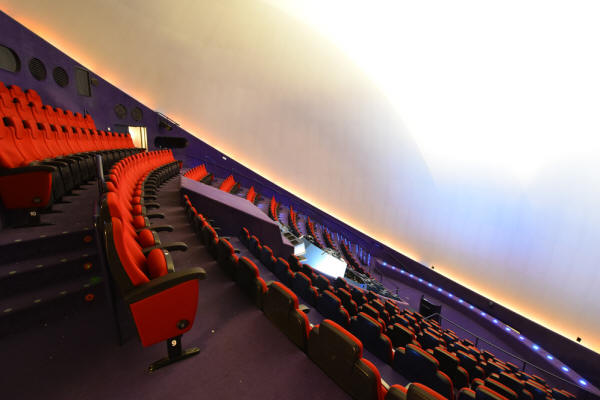 The
Tycho Brahe Planetarium in Copenhagen, and the largest screen in
Denmark - 1000 m2. Completely enveloped by the giant image, the
illusion is like sitting on a mountainside and enjoying the view.
Photo by Thomas Hauerslev The
Tycho Brahe Planetarium in Copenhagen, and the largest screen in
Denmark - 1000 m2. Completely enveloped by the giant image, the
illusion is like sitting on a mountainside and enjoying the view.
Photo by Thomas HauerslevThe history of the technique in the Tycho Brahe Planetarium begins at EXPO '67 in Quebec, Canada and the pavilion "Labyrinth". The attraction was named "In the Labyrinth" and was a large multimedia show that consisted of a mix of 35mm film, 70mm film and slides, which together were to create one large image on several different screens. This movie was the forerunner of the IMAX movie format. It was very complicated to get the pictures to fit together with the many machines and films, and you could always see the joins between the different pictures. It was somewhat analogous to the experience of Cinerama, which was also put together by three strips of film. Roman Kroiter, Robert Kerr and Graeme Ferguson, who produced "In the Labyrinth", began to look around for a simpler way of producing, and showing that kind of film. Their next project was a film for EXPO '70 in Osaka, Japan, produced by Fuji Group. To that end, they founded "Multiscreen Corporation", which later became IMAX Corporation. In Copenhagen, the Norwegian Jan Jacobsen developed the first IMAX camera. It was to accommodate a 65mm wide film that ran horizontally through the camera and where each image was 15 perforations wide. It was to be three times larger than the already-known Todd-AO format. Multiscreen Corporation had also secured the right to use Peter Ronald Wright Jones' unique 35mm "Rolling Loop" film transport system. William "Bill" C. Shaw was one of the founders of the Multiscreen Corporation, and he was given the responsibility of adapting and developing the "Rolling Loop" film projector to the new 70mm film format. The first IMAX projector was installed in the Fuji Pavilion, and the movie "Tiger Child" was shown for six months. Graeme Ferguson's ambition was to subsequently commercialize the big screen and the new projector for regular cinemas. It took almost 50 years for this dream to come true. It happened in 2017 with "Dunkirk", which was almost entirely photographed with IMAX cameras. After EXPO, the machine was sent to Toronto where it was installed in Ontario Place, and the next film in the new format was "North of Superior" in 1971. In March 1973, the first OMNIMAX cinema opened in San Diego, California. Same film format and projector, but designed specifically for dome screens in e.g. a planetarium. A standard IMAX cinema was equipped with a HUGE cinema screen averaging 20 meters in width and 16 meters in height. Sometimes up to 30 meters in width and 20 meters in height. In the commercials, the tag line was: "IMAX was the only movie system that could show a life-size blue whale". It was like being there yourself, watching an IMAX movie thanks to the 70mm system that had an unprecedented resolution and richness of detail. The illusion of reality was overwhelming by virtue of the large film format, the large screen and the immersive multi-channel soundtrack. The films were often produced by North American museums and science centers and for EXPO world exhibitions where special IMAX cinemas were built for the occasion. In 1994, the original IMAX Corporation was sold to an investment fund and the newly constructed company entered the market for "ride films" ("Back to the Future: The Ride") and later it also developed into the IMAX known today from commercial cinemas. |
|
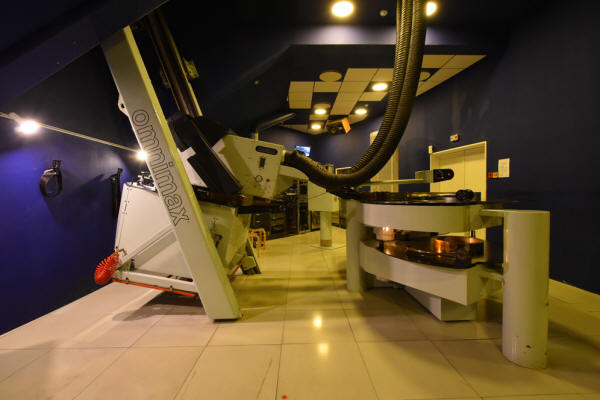 From
the floor of the projection room, the IMAX
GT projector was elevated about 5 meters up via two rails to a "dog
house", which allows the projection lens to be placed approximately
in the middle of the cinema. Image: Thomas Hauerslev From
the floor of the projection room, the IMAX
GT projector was elevated about 5 meters up via two rails to a "dog
house", which allows the projection lens to be placed approximately
in the middle of the cinema. Image: Thomas HauerslevThe Tycho Brahe Omnimax projector arrived in July 1989. Mr Willem Boumeester, European IMAX technician from Rotterdam, installed the IMAX GT (Grand Theater) machine in collaboration with the planetarium staff. It is a very unusual film projector. Roughly speaking, all film projectors - throughout the history of the film - have been standard machines with conventional vertical film movement with intermittent sprockets and feeder/take-out sprockets. The new machine is a Rolling Loop machine, with horizontal film feed. Former Tycho Brahe Planetarium chief projectionist Rene Sørensen explains the movement like this:
• Go to
The Basics of The
Rolling Loop IMAX Projector |
|
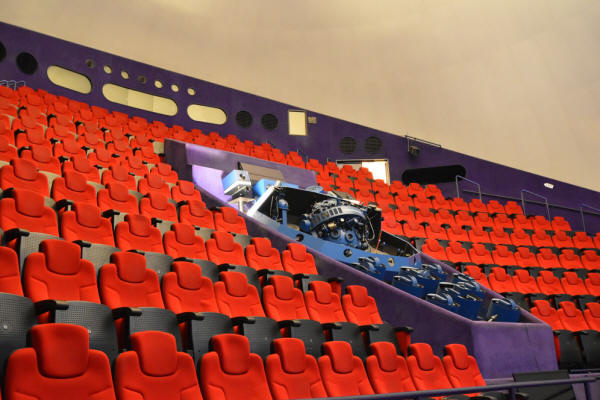 The
IMAX "dog house" can be seen just above the Zeiss astronomy
projector. Image: Thomas Hauerslev The
IMAX "dog house" can be seen just above the Zeiss astronomy
projector. Image: Thomas HauerslevIMAX film is shot in such a way that what is seen takes place 22 degrees below the horizon and 100 degrees above the horizon. The recommended brightness in the middle of the screen is 3 footlambers, which decrease towards the sides. However, the screen in the Planetarium is of a very good quality and can perform 5 footlambers. To illuminate the large screen, it required a water-cooled xenon lamp of 15,000 watts. Normal current is 390 amps and 190 amps at idle. When the lamp is cold, the pressure inside the lamp is 8 atm. This pressure rises to 25 atm when the lamp is operational. The xenon lamp is turned on in the morning and remains switched on all day. The lamp was only switched off after the last performance. The mirror and the dowser were also water cooled. Once the projectionist had laced up the machine and synchronised the audio, the show was ready to be shown. From the floor of the projection room, the machine was elevated about 5 meters up via two rails to a "dog house", which allows the projection lens to be placed approximately in the middle of the cinema. ELCAN (Ernest Leitz of Canada) manufactured the special Fish-Eye projection lenses for OMNIMAX. During the first several years, Planetarium's technique was demonstrated before each performance in the form of sound, slides and lights behind the screen, so you could see the speakers, which were as "big as caravans". It was very fun, entertaining and impressive, emphasizing the function of the Planetarium as a great temple of entertainment that can show fantastic movies and planetarium shows from all parts of our planet, with the most modern cinema technique. By the time of the reopening in late 2020 the IMAX machine had been removed and an era had come to an end in Copenhagen. One can only hope that the digital replacement for IMAX will play well in the planetarium with a new repertoire of movies and astronomy shows. And not least that the many digital projectors together can present a fairly credible illusion of reality. History repeats itself. The producers of "In the Labyrinth" Roman Kroiter, Robert Kerr and Graeme Ferguson abandoned a mosaic image 50 years ago, and instead developed IMAX with ONE large image to achieve the desired quality to achieve as much audience participation as possible. If you have never seen a classic IMAX movie, I can personally recommend the following if the opportunity should present itself some day: "The Dream is Alive", "Sacred Site", "Chronos", "Seasons", "Ring of Fire", "Blue Planet", "Everest", "Fires of Kuwait", "Antarctica", "Titanica", "Shackleton's Arctic Adventure", "Cosmic Voyage" and "Special Effects". They are all among my favorites and some of them can be seen on BluRay and Netflix. However, seeing one of them on such a small screen is only a small replacement, or simply, a meager approximation, compared to the original in OMNIMAX. IMAX at the Planetarium was a unique film experience, which I will never forget. I was always thrilled with the large screen which covered my entire field of view. I loved the JBL speakers and the beautiful 6-channel magnetic analog audio system. It will never be surpassed. Now - unfortunately - it's sadly all over to see 7OMM in the Tycho Brahe Planetarium and (formerly) Omnimax Theater. |
|
Willem Bouwmeester - IMAX Technician |
|
 Thomas
Hauerslev and IMAX Technician Willem Bouwmeester in Copenhagen 3. december
2008. Selfie by Thomas Thomas
Hauerslev and IMAX Technician Willem Bouwmeester in Copenhagen 3. december
2008. Selfie by ThomasIn 1986, I wrote a letter to IMAX Corporation asking for some information about the company's history, technology, movies and cinemas. I got a very nice response, and an invitation to visit an IMAX cinema in the Netherlands so I could see IMAX for myself. • Go to Willem Bouwmeester passed Away A few years later, I was visiting the projection room at the Tycho Brahe Planetarium while the IMAX technician was servicing the system. The technician came from Holland, and at one point he asked me "... do you know Thomas Hauerslev"? I could only answer "yes" to that. The cinema technician's name was Willem Bouwmeester, and he had received a copy of the letter I received from IMAX in 1986. It was the beginning of a friendship with Willem, which has now lasted for more than 25 years. Willem came to Copenhagen three or four times a year to service the IMAX projector in collaboration with the chief operator. Willem was one of IMAX Corporation's most respected cinema technicians, and was occasionally sent on special assignments. I remember, among other things, that he was sent to Melbourne in Australia to fix IMAX problems that the local technician needed specialist assistance to be able to handle. One of the first times he called me, he told that he was on his way to "Tico Brahe", we agreed to meet at IMAX's "office" in Copenhagen. I was hugely impressed, and thought "Cool, IMAX has office here in town!" However, it was an example of Willem's kind of humor, because it turned out that the office was Frida's Bodega on Gammel Kongevej, opposite the Planetarium. At Frida's we met many times - also with the Chief Projectionists Jacob and Rene from time to time - and we talked about IMAX, Cinerama and Todd-AO for the next many years. Willem grew up with Cinerama, and also knew everything about the history of IMAX. Willem was one of the co-founders of "The International Cinerama Society", which purpose it was to re-install CINERAMA in a cinema and revive the fantastic film format. They succeeded in Bradford in 1993. We met in Bradford for Widescreen Weekend many times, and in 1997 Willem, John Harvey and I hosted a "Cinerama Holiday" reunion in Dayton (OH), USA with the film's actors, director and producer. They met all together as a group for the first time since 1955. On the same voyage we also met Bill Shaw, one of the founders of IMAX. The circle was closed. In 2009, after Willem had retired, I visited him at his home in Rotterdam to borrow much of his Cinerama material for publication on in70mm.com's Cinerama page. A few years ago, Willem was unfortunately hit by a blood clot and was admitted to a nursing home in Rotterdam, almost across the road from the Rotterdam CINERAMA Theatre. A poignant end to a long life with movies and cinemas. |
|
| Go: back - top - back issues - news index Updated 22-01-25 |
